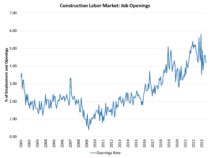Financial conditions continue to tighten, as the 10-year Treasury rate increased to above 4.75%. Among the factors leading to higher rates (more debt issuance, higher-for-longer monetary policy expectations, long-term fiscal deficit conditions, and strong current GDP growth forecasts) was a surprise jump in August for the total number of open, unfilled jobs.
In August, the number of open jobs for the economy as a whole increased to 9.6 million, a significant increase over the 8.9 million estimated total for July. NAHB estimates indicate that this number must fall back below 8 million for the Federal Reserve to feel more comfortable about labor market conditions and their corresponding impact on inflation.
While the Fed intends for higher interest rates to have an impact on the demand-side of the economy, the ultimate solution for the labor shortage will not be found by slowing worker demand, but by recruiting, training and retaining skilled workers. This is where the risk of a monetary policy mistake can be found. Good news for the labor market does not automatically imply bad news for inflation.
The construction labor market continued to cool in August. The count of open construction jobs decreased to 350,000. This estimate comes after a data series high of 488,000 in December 2022. The overall trend is one of cooling for open construction sector jobs as the housing market slows and backlog is reduced, with a notable uptick in month-to-month volatility since late last year.
The construction job openings rate held at 4.2% in August. The recent trend of these estimates points to the construction labor market having peaked in 2022 and is now entering a stop-start cooling stage as the housing market adjusts to higher interest rates.

Despite additional weakening that will occur in the second half of 2023, the housing market remains underbuilt and requires additional labor, lots and lumber and building materials to add inventory. Hiring in the construction sector fell back to 4.4% in August after 4.8% in July. The post-virus peak rate of hiring occurred in May 2020 (10.4%) as a post-covid rebound took hold in home building and remodeling.
Construction sector layoffs fell back to 2% in August after 2.2% in July. In April 2020, the layoff rate was 10.8%. Since that time, the sector layoff rate has been below 3%, with the exception of February 2021 due to weather effects and March 2023 due to some market churn.
Looking forward, attracting skilled labor will remain a key objective for construction firms in the coming years. While a slowing housing market will take some pressure off tight labor markets, the long-term labor challenge will persist beyond the ongoing macro slowdown.
Discover more from Eye On Housing
Subscribe to get the latest posts to your email.


I think you meant to say 30 year mortgage rate instead of 10 year treasury rate in that first sentence. The 10 year treasury is at 4.7% this morning.
Yes….thank you, that typo was corrected. Thanks.
The rising job openings mentioned in the article could influence construction loans. Growing employment opportunities often signify a robust economy, prompting lenders to adjust interest rates. For the construction loan sector, this might mean slightly higher rates. Borrowers seeking construction financing should be mindful of these rate changes, as they could impact the overall cost of their projects.